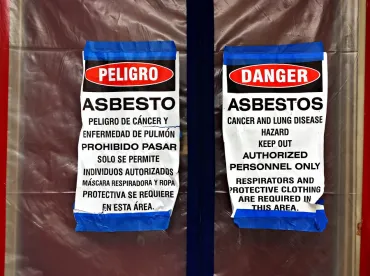A common question that arises when performing environmental due diligence on commercial real estate is the degree to which the presence of asbestos-containing materials (ACMs) should be investigated. In the case of ACMs, “what you don’t know can hurt you” and, therefore, the old axiom of “less is more” does not apply. This is especially true regarding asbestos not only in terms of health risks, but also from a regulatory perspective where parties can be held “strictly” liable without regard to knowledge or intent.
Those who regularly deal in commercial real estate are likely familiar with the need to obtain a Phase I Environmental Site Assessment, which is designed to identify the presence or likely presence of a release of hazardous substances and petroleum products on a commercial property. A valid Phase I is a prerequisite to qualifying for certain protections from liability under the Comprehensive Environmental Response, Compensation and Liability Act of 1980 (CERCLA). Even though asbestos is a hazardous substance, it is generally not investigated in a Phase I largely because Section 104(a)(3) of CERCLA exempts ACMs as “building materials” when incorporated as part of the structure, or as a “naturally occurring substance” at a property. While there may be unique scenarios where an environmental professional will call out the presence of ACMs in a Phase I–such as former asbestos manufacturing sites or where ACMs were disposed of–the consultant will generally not investigate ACMs incorporated into structures on the property as part of routine due diligence.
Instead, investigation into the presence of ACMs is a “non-scope consideration” under ASTM Standard Practice E1527-13, which is a class of issues that are not required to be considered in the Phase I ESA (but can be included in the Phase I for an additional fee). Even where these services are requested, attention should be paid to how the environmental professional assesses ACM issues. Some consultants may only “screen” for suspect ACMs based upon the date of construction occurring after certain federal bans were implemented in the 1970s. However, unlike the bright-line ban in 1978 on the use of lead-based paint, the asbestos bans are more nuanced and prohibit only certain products and applications, such as some qualifying pipe insulation and spray on surfacing ACMs. ACMs continue to be manufactured and used extensively in building materials to this day, including (but not limited to) vinyl flooring, pipeline wrap, and roofing materials. While screening may offer a generalized risk profile for a property, it will not provide insight into specific risks. If an assessment of specific asbestos risks is needed for a property (for instance, where invasive renovations are planned), an asbestos survey by an accredited asbestos specialist is the best and only means to achieve this.
Moreover, if a renovation or demolition project is planned for the property, a survey is required prior to any activities that would impact ACMs. US EPA’s National Emissions Standards for Hazardous Air Pollutants (NESHAPs) for asbestos issued under the Clean Air Act require that owners and operators of demolition or renovation activities: (1) conduct a pre-activity survey by an accredited asbestos specialist, (2) provide written notice to the relevant agency 10 days prior to demolition and renovation activities when ACMs exceed certain amounts, and (3) employ various precautions and work practices during demolition and renovation activities (e.g. enclosure of work areas, keep ACMs wet during work, proper bagging and disposal of waste materials, etc.). Likewise, corollary state and local programs implement fundamentally similar requirements.
Similarly, the Occupational Safety and Health Administration has issued general occupational and construction standards that require employers and building and facility owners to determine the presence, location, and quantity of ACMs at workplaces and provide notification to employees and tenants, as well as to prevent employee exposure to airborne ACMs above certain permissible exposure limits (PELs). Because ACMs can be broken up (made “friable”) into dust-sized particles that can disseminate through HVAC systems, a minor maintenance project that dislodges ACMs can quickly generate a facility-wide exposure concern. A survey to assess ACM locations combined with an Operations & Maintenance Plan that educates maintenance staff and establishes appropriate procedures can avoid exposure risks and the need for extensive abatement and remediation.
Historical surveys and abatement information can provide a degree of confidence, but must be scrutinized carefully in the course of performing environmental due diligence. A given property may undergo years of investigations and abatement activities, and still not be completely understood. Surveys are commonly limited in scope or provide only a “representative” assessment, particularly in multi-unit scenarios. Further, as rehabs are performed, materials can be swapped out and areas that may have previously contained no ACMs, now contain newer materials of concern. As a result, historical summary reports that ostensibly provide an “all clear,” may actually deliver less than promised.
While the shortest route to liability is to fail to have a proper survey performed, ACMs can present numerous other challenges ranging from regulatory compliance with work site practices to construction management issues, such as selection of and coordination between subcontractors. All it takes is for a neighbor to complain to the local air agency regarding dust from the construction site to trigger an investigation that leads to costly enforcement, which may be brought against the property owner, the contractor or both. Civil penalties can accrue on a daily basis and quickly result in tens to hundreds of thousands of dollars, while the costs associated with project delay may magnify the financial impacts. Indeed, ignorance is not bliss when it comes to ACMs and those who anticipate acquiring a property should plan for adequate due diligence and familiarize themselves with the risks and legal requirements associated with the presence of asbestos.




 />i
/>i

